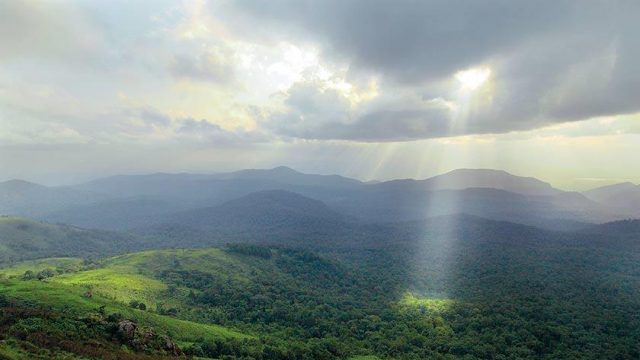In July 2012, the Western Ghats were named a World Heritage Site, adding to a growing list of sites around the world that celebrate human endeavour and natural splendour. The hill range has long enjoyed iconic status among people interested in nature and wildlife. One organisation, Conservation International, branded it as one among thirty-four ‘biodiversity hotspots’ in the world. And now Unesco has formally recognised what wildlife enthusiasts have long known that the Western Ghats are a wonder of the natural world, on par with the more famous Ngorongoro Conservation Area, Tanzania.
However, only a third of the original 160,000 sq km of forests in the Western Ghats is left. The Unesco status does not extend to the entire hill range or even to what remains of the natural vegetation. After a rigorous process of evaluation, thirty-nine sites were identified, of which nineteen are in Kerala, ten in Karnataka, six in Tamil Nadu and four in Maharashtra. These reserve forests, tiger reserves, wildlife sanctuaries and national parks cover an area of some 8,000 sq km and are already governed by the Wildlife Protection Act, the Forest Conservation Act and the Forest Rights Act.
Jagdish Krishnaswamy of the Ashoka Trust for Research in Environment and Education (ATREE) says these sites showcase “exceptional natural beauty, major geological features, [and] have examples of ongoing biological and ecological processes, and habitat for biodiversity to flourish. These sites are along the rainfall gradients from south to north, west to east, as well as a range of habitats from swamps, grasslands, and streams to thick rainforests.”
The Western Ghats are not the only natural forests to be declared a World Heritage Site in India. In 1985, Manas National Park and Kaziranga National Park in Assam and Keoladeo National Park in Rajasthan were India’s first, followed by Sunderbans National Park in 1987 and Nandadevi and Valley of Flowers in the Himalaya in 1988. More than twenty years later, the Western Ghats have become the sixth site to get this distinction.
The World Heritage Site tag will magnify international attention on the conservation of these areas. Donors readily fund projects in such locations, while the world media is also likely to highlight any threat to such Heritage Sites. By nominating the Western Ghats, the Government of India has tacitly undertaken to do everything in its powers to provide security for these forests in the future.
It’s likely the high profile of this listing will bring more tourists. These are fragile ecosystems; more footfalls can jeopardise their existence as we know them today. While a few areas, such as the Periyar Tiger Reserve, are well-known tourist destinations, some of the sites have no facilities and are unlikely to play host to anyone but the most persistent researcher. Besides, the Ministry of Environment and Forests has now issued guidelines to regulate tourism in all protected forests.
Not only the rich array of life forms, but about 150 million people live in the humid hill range. Krishnaswamy says, “It is the most densely populated biodiversity hotspot in the world. Yet, grasslands that were formed 40,000 years ago still persist despite human development all around. It’s a unique place.”
What if India fails to safeguard a World Heritage Site? India had its anxious moments with some sites such as the Taj Mahal and Manas National Park. In 1992, Bodo insurgency endangered the integrity of Manas which was put on the danger list. After several corrective steps were taken to protect it, it was removed from the list last year. Even our most cherished Heritage Site, the Taj Mahal, was placed in danger by the Uttar Pradesh Government’s infamous Taj Corridor Project.
In November 1999, Hampi’s spectacular ruins of the Vijayanagar Empire, another World Heritage Site, were put on Unesco’s List of World Heritage in Danger. The Karnataka government had begun construction of two bridges—one for pedestrians and the other for vehicular traffic—spanning the Tunga-bhadra without seeking clearances from the Archaeological Survey of India or the Hampi World Heritage Site Management Committee. Worse, the state had callously removed a monument that was in the way of one of the bridges. The global body threatened to strike Hampi off its prestigious list and demanded a halt to construction. But the local people really wanted the bridges. Until then, the only means of crossing the river was by coracles; they filed a Public Interest Litigation. Finally in 2003, Unesco granted provisional approval for the vehicular bridge. Barely two months after work resumed, the bridge collapsed, killing eight. The authorities are still scoping the area for a site to build a new bridge.
In 2006, Hampi was taken off the List of World Heritage in Danger. At this time, biologists along the Western Ghats were engaged in the process of compiling data to nominate the Western Ghats as a World Heritage Site. Many conservationists believe we should be proud of the global recognition for the hill range. It could do no harm. However, such tags wield enormous power to interfere with local people’s rights and aspirations.
Perhaps, more than global recognition, the Western Ghats need regional and national appreciation. In a country where forests are undervalued and unappreciated, an international tag could do the trick of getting local people to cherish the treasure in their own backyards. But with Karnataka raising the pitch in its opposition to the Unesco tag, the space for conservation has narrowed considerably.




